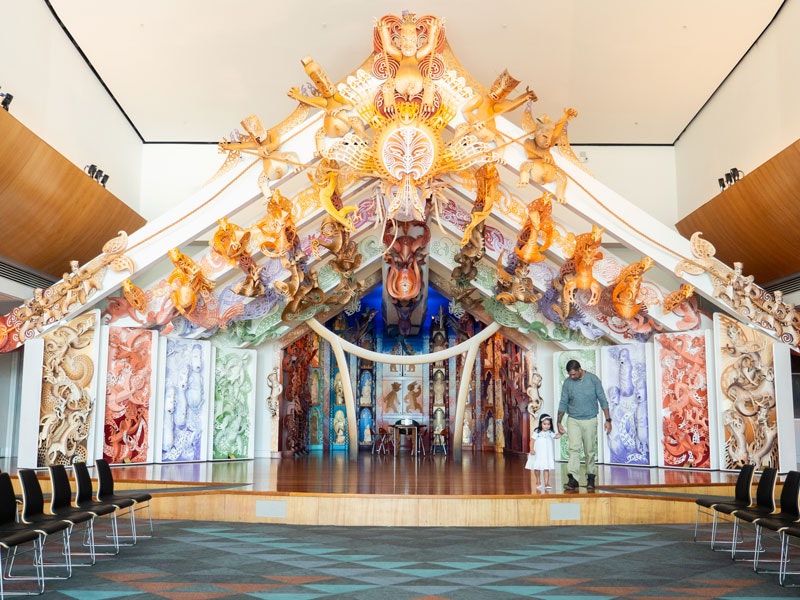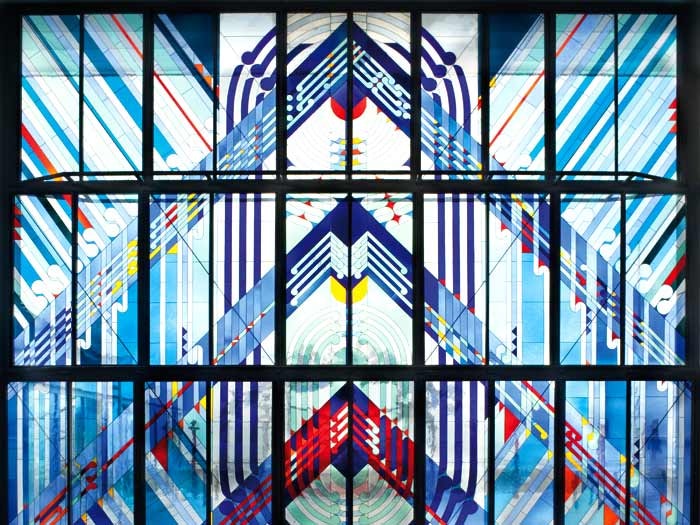For Māori, the marae is a focal point of identity where all connected kinship groups – whānau, hapū, and iwi – meet to discuss and debate, to celebrate, to welcome the living, and to farewell those who have passed on. There are more than one thousand marae up and down Aotearoa New Zealand.
The marae at Te Papa is called Rongomaraeroa and was purpose built for the new museum that opened in 1998. It has been fundamental to enabling Te Papa to be able to honour, host and uplifting all peoples, iwi, hapū, whānau, and hapori in relation to their taonga and the kaupapa in a Māori-centered way.
Heart of Te Papa
Rongomaraeroa or Te Marae o Te Papa Tongarewa, is like any other marae in the country, except that its ‘kinship group’ is established as agreed upon with mana whenuaiwi groups, to encompass all Tangata Whenua peoples and other cultures whose taonga and treasured items that are cared for at Te Papa.
Rongomaraeroa, 2013. Photo by Te Papa
When the new museum was in development in 1989 there was a decision to build a marae within the museum.
The kaupapa to develop a fully functioning marae within a museum posed many challenges and at the same time many opportunities.
It required various stakeholders to agree and commit to honouring the unique position Māori hold as Tangata Whenua of Aotearoa New Zealand and address less respectful positionings of the museum’s predecessors.
This fundamental step to develop a ‘new museum’ that could shift museum practices and priorities to be more aligned to the aspirations of Te Tiriti o Waitangi | The Treaty of Waitangi represents the essence of Te Papa.
A place where everybody can have a sense of belonging and be empowered to look forward to a more equitable future.
Te ao Māori
Te ao Māori – the Māori worldview – acknowledges the interconnectedness and interrelationship of all living and non-living things.
For Rongomaraeroa, whakapapa and whanaungatanga are crucial elements in maintaining te ao Maori.
This framework defines the processes, rituals, and functions that Rongomaraeroa is enabled to provide Te Papa.
Mana Taonga Principle
The marae would also embrace the concepts of the newly adopted Mana Taonga Principle. The principle was designed in consultation with iwi and stakeholders across Aotearoa by Ngā Kaiwawao. Ngā Kaiwawao was the Māori advisory group to the Musuem development board. The Mana taonga concept was presented to the museum development board on the 30th September 1992 and was accepted to become one of the foundational principles of Te Papa.
The Mana Taonga Principle exemplifies the principles and aspirations of Te Tiriti o Waitangi | The Treaty of Waitangi and is a Māori-centered principle created and articulated for the museum to ensure that Māori (and other taonga communities) are vital in the understanding, display, and care of their taonga.
Opening of Rongomaraeroa, 1997. Photo by Norm Heke. Te Papa (110586)
Who created Rongomaraeroa and when?
The concept and oversite of Rongomaraeroa was created by master carver and the inaugural Kaihautū of Te Papa, Cliff Whiting (Te Whānau-ā-Apanui).
The official opening of Rongomaraeroa was 30 November 1997. This was three months before the opening of the entire Museum of New Zealand Te Papa Tongarewa on the 14 February 1998.
Cliff Whiting in front of Te Hono ki Hawaiiki. Photo by Norm Heke. Te Papa (112933)
The marae was intended to be a contemporary marae where its unique context would centre te ao Māori while openly supporting a connection to the whakapapa of Aotearoa New Zealand.
It would include parts a marae might require to provide manaakitanga within the context of a museum, as well as a fully functioning communal centre, run according to Māori kawa and tikanga.
Although the house takes centre stage as a contemporary wharenui, the floor, walls, hosting facilities, and each entranceway all have roles to play within the function and values of our marae.

